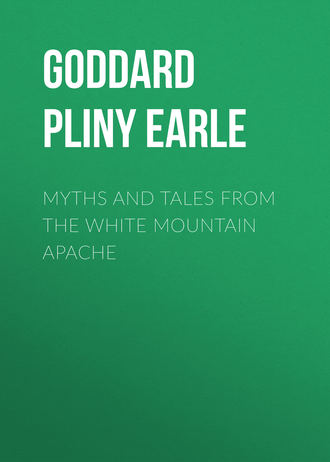 полная версия
полная версияMyths and Tales from the White Mountain Apache
32
These monsters are not those in the usual versions. The bringing of trophies and the narratives remind one of counting coup in the Plains. The Navajo versions also mention the bringing back of trophies.
33
One of the recognized methods of rapid locomotion. P. 20 above.
34
The dispersion of the tribes, a common incident in origin myths.
35
The formula for the completion of a narrative.
36
Told by the father of Frank Crockett, February, 1910. Frank's father was of the Bissaxa clan and was about sixty years old in 1910. He was still a growing youth when he left the White River country.
37
These in part are the obstacles mentioned in the Navajo account. They are overcome in a different manner. Matthews, 109-110.
38
Spider-woman is of considerable importance in the mythology of the Hopi. Voth, 2, 11. The Navajo account (Matthews, 109) omits the clothing-making episode. Spider-woman is the originator of spinning, Franciscan Fathers, 222. She is sometimes said to be the mother of the Sun and therefore Naiyenezgani's paternal grandmother.
39
An Apache method of indicating time when the Sun is near the horizon.
40
The blanket was probably a cloud. The word caziz ought to mean “sun-sack.”
41
Had Naiyenezgani taken the gun Indians would have been armed as white men are.
42
Told in 1910 by a very dignified man, C. G. 2, of about sixty years. He is a leader of the Naiyenezgani songs used for adolescent girls.
43
The lightning strikes with him, evidently a poetic name.
44
It was explained that four was the real number, thirty-two being presumably a ceremonial or poetic exaggeration.
45
“Goes by day,” the Sun.
46
This fragment of the culture-hero story having been told, the narrator refused to proceed, perhaps because he knew it had already been several times recorded.
47
Told by Frank Crockett's father in part, and extended by Frank who was interpreting.
48
Told by the father of Frank Crockett, February, 1910.
49
Told by the father of Frank Crockett.
This is a very widely distributed tale. The owner of the animals is usually Raven or Crow. See this series, vol. 8, 212-4; Russell, 259; Wissler and Duvall, 50-53; Kroeber, 65; this series, vol. 10, 250-251.
50
Ganisk'ide is a deity known to the Navajo, Matthews, 37, 244.
51
Told by Frank Crockett's father following the preceding story so closely as to make its separation a matter of doubt. A fuller version was obtained from a San Carlos, p. 49, above.
52
Told by Frank Crockett's father who practised the ceremony. It is for the recovery of those who have been made ill by the floods due to thunderstorms.
53
A gambler made desperate by his losses is the hero of a Navajo (Matthews, 160) and a Jicarilla story (This series, vol. 8, 214).
54
A messenger wears a downy feather tied at the crown of his head and is protected by it on his journey. It serves as a safe conduct.
55
These four paragraphs appear to contain the words of songs.
56
As high as a man's head.
57
Clearly a song.
58
Because one supposedly dead was being mentioned to a near relative.
59
Told by the father of Frank Crockett in February, 1910. For the distribution of this story see p. 67 above. It was said to be the myth of a ceremony used to cure one who gets ill from eagle feathers when he uses them to put on his arrows.
60
This method of knowing when the parents are to return is found in another myth, p. 17 above.
61
A similar supplying of his wants is in the Navajo account, Matthews, 199.
62
Told by the father of Frank Crockett in February, 1910. This is the myth upon which the ceremony for curing one bitten by a snake rests. For the San Carlos version see p. 64 above.
63
A valley on Cedar Creek in the White Mountain country.
64
This knowledge of geography by a bird-old-man is found in a San Carlos story, p. 21.
65
The deities and materials have definite associations with the world-quarters. There are certain variations in this association.
66
This refers to rattlesnakes under the mesquite bushes where they are said to be frequently encountered. The male above is probably the lightning which from this narrative appears connected with the porcupine.
67
Told by the father of Frank Crockett in February, 1910.
68
Told by the father of Frank Crockett, February, 1910.
69
Told by the father of Frank Crockett.
70
This incident is generally known over western North America. Professor Boas has discussed its distribution.

